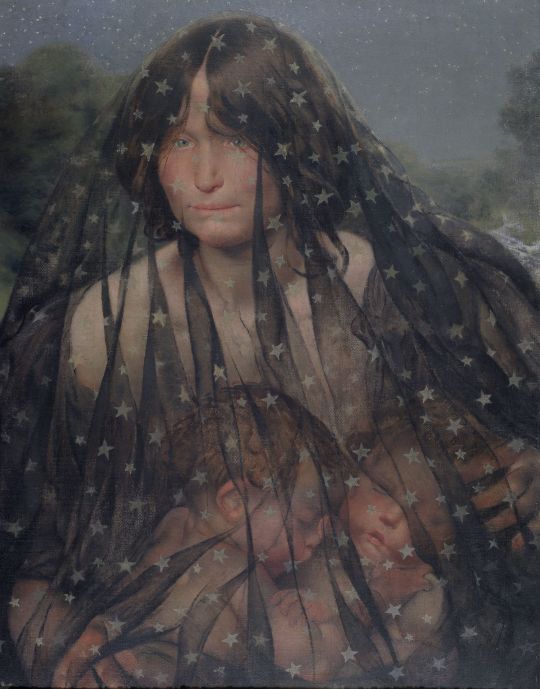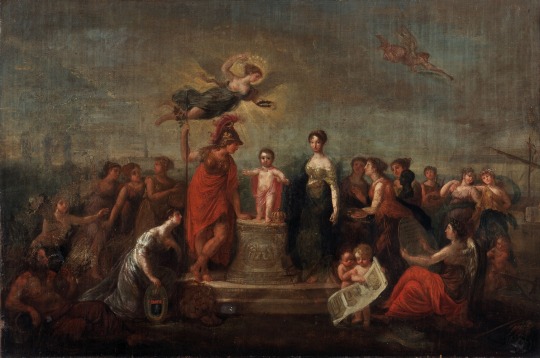#museum of fine arts ghent
Explore tagged Tumblr posts
Text

Allegory of Night, Léon Frédéric, 1891
#art#art history#Léon Frédéric#night#allegory#allegorical art#Symbolism#Symbolist art#Belgian art#19th century art#oil on canvas#Museum of Fine Arts Ghent
2K notes
·
View notes
Text

Portrait of Empress Josephine
Artist: Joseph Paelinck (Belgian, 1781-1839)
Date: c. 1807-1808
Medium: Oil on canvas
Collection: Museum of Fine Arts Ghent, Ghent, Belgium
Joséphine de Beauharnais
Joséphine Bonaparte (23 June 1763 – 29 May 1814) was the first wife of Emperor Napoleon I and as such Empress of the French from 18 May 1804 until their marriage was annulled on 10 January 1810. As Napoleon's consort, she was also Queen of Italy from 26 May 1805 until the 1810 annulment. She is widely known as Joséphine de Beauharnais
#portrait#full length#oil on canvas#art#empress josephine bonaparte#french royalty#french monarch#empress of the french#gold color dress#embroidery#crown#necklace#french history#french monarchy#belgian culture#belgian art#oil painting#fine art#artwork#belgian painter#joseph paelinck#european art#19th century painting#museum of fine arts ghent
24 notes
·
View notes
Text


Allegory of the Birth of the King of Rome, 1811
Ernest Joseph Bailly
Museum of Fine Arts Ghent
#Ernest Joseph Bailly#Bailly#Napoleon ii#Duke of Reichstadt#king of Rome#Museum of Fine Arts Ghent#Flemish institute of archives#napoleonic era#napoleonic#napoleon#napoleon bonaparte#first french empire#french empire#history#19th century#painting#Flemish#Flemish art#baroque#Marie Louise of Austria#Marie Louise#Marie-Louise#neoclassical#art#paintings#19th century art
75 notes
·
View notes
Text

Jaël Killing Sisera in his Sleep
Artist: Anonymous Master, Netherlands
Date: 17th-18th century
Medium: Oil paint on canvas
Collection: Museum of Fine Arts, Ghent, Belgium
The Story of Jael, Book of Judges
Jael in the Bible was the wife of a man named Heber, who was a Kenite. The Kenites were related to the Midianites. Jael features in the book of Judges as a heroic woman who killed Sisera, the leader of King Jabin’s Canaanite army. Jabin was trying to conquer Israel, which was at that time under the leadership of Deborah, a prophetess and the only female to judge the nation of Israel.
When Sisera and his army came against Israel, Deborah sent word to Barak of the tribe of Naphtali that he was to fight the Canaanites and deliver Israel from Jabin’s hand. Barak was unwilling to go into battle without Deborah by his side. Deborah agreed to go with him but told him that, because of his reticence, a woman would get the honor of killing Sisera, the captain of Jabin’s army (Judges 4:4–7).
As the Israelites were winning the battle, as prophesied by Deborah, Sisera left his decimated army at the Kishon River and fled on foot (Judges 4:16–17). He came to Heber’s property and sought refuge there, knowing that Heber was in alliance with King Jabin. Heber’s wife, Jael, welcomed Sisera with the words “Come, my lord, come right in. Don’t be afraid” (Judges 4:18). She brought Sisera into her tent, covered him with a blanket, and gave him some milk to drink (verses 18–19). Jael was kind and hospitable, but she had an ulterior motive. After Sisera had eaten well and was asleep, Jael took a tent peg and a mallet and sneaked up on Sisera. She placed the tent peg’s point on his temple and hit the peg with the mallet, driving it through his temple with such force that it stuck in the ground on the other side of his head. Thus Sisera died (Judges 4:21).
Deborah’s prophecy was fulfilled: the honor of killing the captain of Jabin’s army went to a woman. That woman was Jael. As Barak pursued Sisera, he came to Heber’s settlement. Jael went to meet him and brought him into the tent to show him what she had done - Sisera’s body was lying there with a tent peg in his temple (Judges 4:22). Later, Barak and Deborah sang a song of the battle, and in the song they honored Jael by name:
“Most blessed of women be Jael, the wife of Heber the Kenite, most blessed of tent-dwelling women. He asked for water, and she gave him milk; in a bowl fit for nobles she brought him curdled milk. Her hand reached for the tent peg, her right hand for the workman’s hammer. She struck Sisera, she crushed his head, she shattered and pierced his temple. At her feet he sank, he fell; there he lay. At her feet he sank, he fell; where he sank, there he fell - dead” (Judges 5:24–27).
#biblical scene#biblical art#christianity#artwork#oil on canvas#fine art#netherlandish art#landscape#tent#horse#jael#sisera#drapery#book of judges#biblical story#holy bible#old testament#oil painting#european art#museum of fine arts ghent
10 notes
·
View notes
Text

Robber's Wife with Child on the Run
Artist: Adolphe Bernard (Belgian, 1812-1890)
Date: 1834
Medium: Oil on canvas
Collection: Museum of Fine Arts Ghent, Belgium
#painting#art#oil on canvas#woman#child#landscape#female figure#baby#costume#headpiece#necklace#earrings#mountains#hiding#belgian culture#belgian art#adolphe bernard#belgian painter#19th century painting#european art#genre art#oil painting#fine art#artwork#museum of fine arts ghent
22 notes
·
View notes
Text

Alfred Stevens (Belgian, 1823–1906)
Maria Magdalena [Sarah Bernhardt], 1887, Museum voor Schone Kunsten
Oil on canvas
#oil on canvas#painting#Alfred Stevens#belgian#mary magdalene#sarah bernhardt#19th century#Museum voor Schone Kunsten#ghent#Museum of Fine Arts Ghent#portrait
3 notes
·
View notes
Text

Charles Picqué, 1799-1869
Hebe, ca.1826, oil on canvas, 260x197 cm
Museum of Fine Arts Ghent, Belgium Inv. 1826-A
3K notes
·
View notes
Text

Louis Maeterlinck (Belgian, 1846-1926) Cruel Love, 1889 Museum of Fine Arts, Ghent
#Louis Maeterlinck#Belgian art#Cruel Love#1889#art#fine art#european art#classical art#europe#european#fine arts#oil painting#europa#mediterranean#Belgian#Belgium
356 notes
·
View notes
Text

Title: Brussels in the Rain Artist: Gustave Den Duyts (Belgian, 1850-1897) Date: unknown Genre: cityscape Medium: oil on panel Dimensions: 26.9 cm (10.5 in) high x 38 cm (14.9 in) wide Location: Museum of Fine Arts Ghent (MSK), Belgium
#art#art history#Gustave Den Duyts#cityscape#Brussels#Belgium#rain scene#Belgian art#19th century art#oil on panel#Museum of Fine Arts Ghent
56 notes
·
View notes
Text

Emperor Charles and His Mistress Johanna Van der Gheynst at the Cradle of their Daughter Margaret
Artist: Théodore-Joseph Canneel (Belgium 1817-1892)
Date: 1844
Medium: Oil paint on canvas
Collection: Museum of Fine Arts Ghent, Belgium
Description
In this genre scene, Théodore Jozef Canneel gives us a romanticized picture of the emperor’s private life. In 1522, Johanna van der Gheynst, the daughter of a tapestry-weaver in the region of Oudenaarde, gave birth to a daughter who later became Margaret of Parma. Canneel’s work is sober, with an eye for detail, but unlike Henry Leys, his historic realism is always secondary to the story. In addition to portraits, historical work and genre scenes, Canneel also focused on monumental painting.
#painting#genre art#emperor charles v#interior scene#holy roman emperor#johanna van der gheynst#man#woman#baby#craddle#cloak#basket#textiles#table#door#hat#belgian culture#belgian art#oil on canvas#artwork#oil painting#fine art#house of hasburg#austrian history#theodore joseph caneel#belgian painter#european art#19th century painting#museum of fine arts ghent
21 notes
·
View notes
Text

Charles Picqué (Belgian, 1799-1869) • Self-Portrait • 1833 • Museum of Fine Art, Ghent, Belgium
Charles Picqué was a Belgian painter, lithographer and engraver known for his neo-classical and romantic works. He was distinguished in several fields: portraiture, landscape, still-life, sacred art and history painting. – Wikipedia
As I was looking into this artist I came upon this painting by him and was struck by the resemblance of the sitter to the artist's self-portrait. The tilt of the head, the facial features, as well as the right hand – the artist holding a brush, the woman her long hair.

Woman at her toilet • 1827
#art#art history#painting#oil painting#self portrait#charles picqué#belgian artist#neo classicism#romanticism#19th century european art#self-portrait#artist as subject#the canvas mirror art blog#art blogs on tumblr
108 notes
·
View notes
Text

The Beautiful Anthia Leading her Companions into the Temple of Diana in Ephesus
Artist: Joseph Paelinck (Netherlandish, 1781-1839)
Date: c. 1820
Medium: Oil on canvas
Collection: Museum of the Fine Arts, Ghent, Belgium
Description
In The Beautiful Anthia Joseph Paelinck depicts an episode in an ancient Greek tale. During a parade in the temple of Artemis in Ephesus the proud warrior Abrocomeus met the beautiful Anthia. Eros, the god of love, was vexed by Abrocomeus’s indifference and contrived to make him fall passionately in love with the young woman. They married, but Eros’s revenge continued to persecute them. They were kidnapped by pirates, sold as slaves, separated from one another but eventually their love and fidelity helped them overcome their trials and tribulations. The story lends itself perfectly to propagating the nineteenth-century bourgeois moral values. The painting depicts the parade with Anthia in the centre and Abrocomeus to the right in his red coat. The theme, the balanced composition and the careful rendition contribute to making this painting an excellent example of the Classic ideal of Paelinck and other followers of Jacques-Louis David.
#goddess of swamps and flowery wreaths#artwork#painting#mythological scene#antheia#temple of diana#ephesus#female figures#classic columns#wreaths#oil on canvas#netherlandish culture#netherlandish art#fine art#oil painting#mythological characters#joseph paelinck#netherlandish painter#european art#greek mythology#19th century painting
42 notes
·
View notes
Text

Louis Maeterlinck (Belgian, 1846-1926)
Cruel Love, 1889
Museum of Fine Arts, Ghent
10 notes
·
View notes
Text

Fernand Khnopff - Landscape at Fosset, between circa 1890 and circa 1895, Museum of Fine Arts Ghent (MSK)
9 notes
·
View notes
Text

Anonymous master, Portrait of Philip the Fair and Isabella of Portugal, c. 1550 Museum of Fine Arts Ghent
3 notes
·
View notes
Text

Joseph Stallaert, 1825-1903
Polyxena sacrificed on Achilles' pyre, 1875, oil on panel, 77.5x57.5 cm
Museum of Fine Arts Ghent, Belgium Inv. 1877-E
94 notes
·
View notes